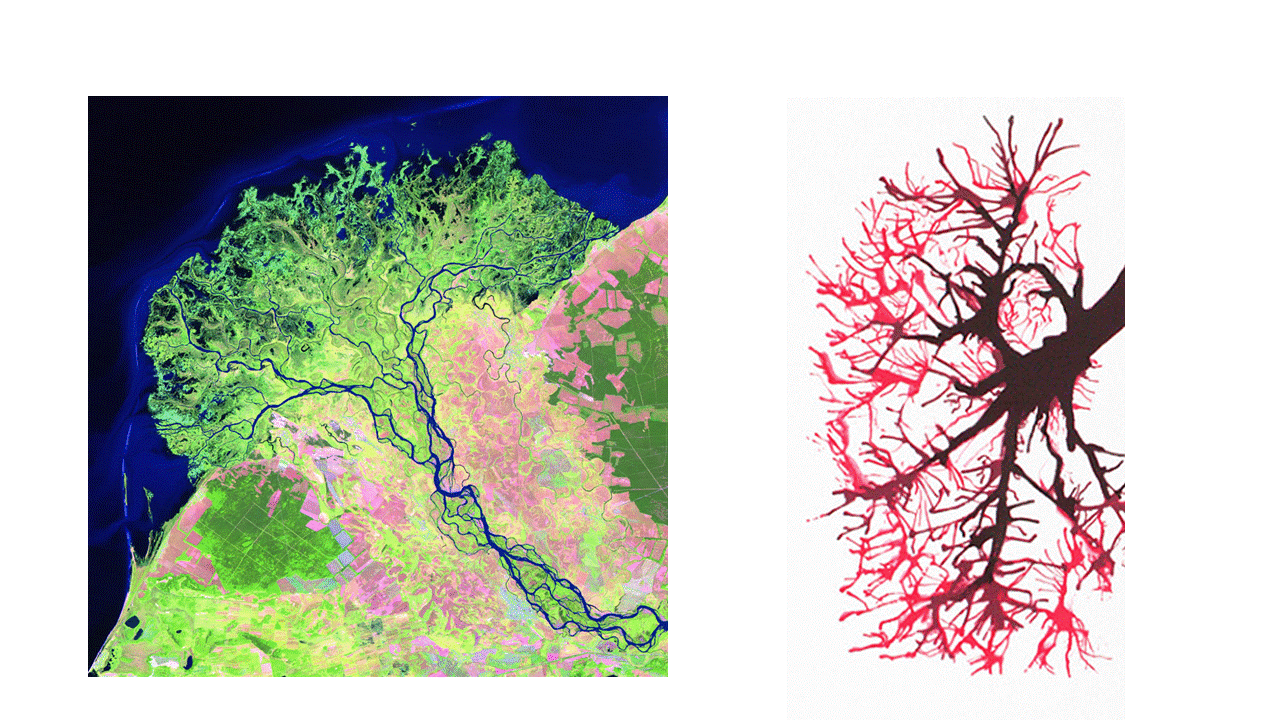
“Whether it be the sweeping eagle in his flight, or the open apple-blossom, the toiling workhorse, the blithe swan, the branching oak, the winding stream at its base, the drifting clouds, over all the coursing sun, form ever follows function and this is the law.” — Louis Sullivan 1896
How Thermodynamic Laws Shape Structures
The challenge any engineer faces is the optimal form for a design. Why is a try shaped like a tree? And why does this look like a river delta, or a lung, or a neuron?

In the 1990’s mechanical engineering professor Adrian Bejan developed the “Constructal Law of Thermodynamics“. Bejan concluded that entropy generation causes design structures to evolve in order to maximize flow. In the case of the river delta, and lung above these tree-like structures are all maximizing flow of mass, and thereby entropy generation. Diffusion constants for Mass, Momentum, Heat, Chemical potential, and Electricity (basically transport of any physical phenomena) are all coupled to the entropy generation term through Onsanger’s non-equilibrium thermodynamics. By constructing an entropy balance you can analyze the generation term to see that any flowing system will maximize the entropy generation term through readily calculable branching ratios. Bejan was able to construct computer algorithms that could predict the shapes of trees and other flow systems, ultimately concluding that this meant tree-like structures are optimal — which very well could be the case for flow systems based on mass.
Look at the universe though, and we realize very quickly that all structures in nature do not evolve into tree-like hierarchies. Planets, solar systems, galaxies, and social networks have very different structures as they do not rely primarily on continuous mass transport. Yet the thermodynamic laws are universal. So how can we use these laws to understand something like the shapes of social structures?
The structure of social networks
Social networks are built upon information exchange/diffusion mechanisms. All information diffusion mechanisms have varying degrees of strengths and weeknesses, which result in blind-spots or information that the network just misses. So it can be seen how these information exchange mechanisms, in-turn, shape and structure the social network, which creates a resource hierarchy for the network, which in turn shapes the network’s values.
Hear’s a graphic for how these information structures have evolved hand-in-hand with value Memes over time.

What you can see from the figure above is that each information storage mechanism works for a particular spiral value meme (which the corresponding network maps are from): 1. Survival, 2. Tribal, 3. Authoritarian, 4. Legalistic, 5. Performance, 6. Communitarian, 7. Systemic, and 8. Global/Holistic. Remember that all of the mechanisms/value levels matter and are useful in specific situations, yet evolved to serve differing needs through time. Each one of these information diffusion mechanisms likely has it’s own diffusivity property; similar to the mass, momentum, chemical, thermal, and electrical diffusivities in traditional thermodynamic space. It’s going to take some work to calculate these information diffusivity values for every instance or case.
From the structure of thermodynamics, and with the assertion that empathy is the social equivalence of entropy, we can see that social information structures can evolve from the laws of thermodynamics similar to mass based diffusion structures. As your social network evolves, you’ll get good at optimizing a particular value set, only to realize that the values your particular information structure has evolved for start missing another set of values that have become the sensitive parameter(s), and you’ll start structuring information to adapt to that new value set. This gets at the sophistication vs. evolution problem — you can become increasingly specialized and sophisticated in a particular value set for a particular problem but at some point you need to evolve to a new paradigm — it’s local vs. global optima. As the information diffuses, empathy generation occurs and increases as we seek to maximize the flow of information.
So the take-away — empathy, like entropy, is key to the transport and diffusion of information in a directly analogous way to the transport and diffusion of energy and mass. This transport and associated entropy/empathy generation creates the associated information and physical structures we see and use everyday. Every structure has it’s limits, and hence a resource and value hierarchy emerges to correspond to the structure. This is going to take awhile to fully unpack…
(Note: this post is one chapter of what could become a book someday. The other chapters can be found here: https://hydrogen.wsu.edu/dr-jacob-leachman/ )